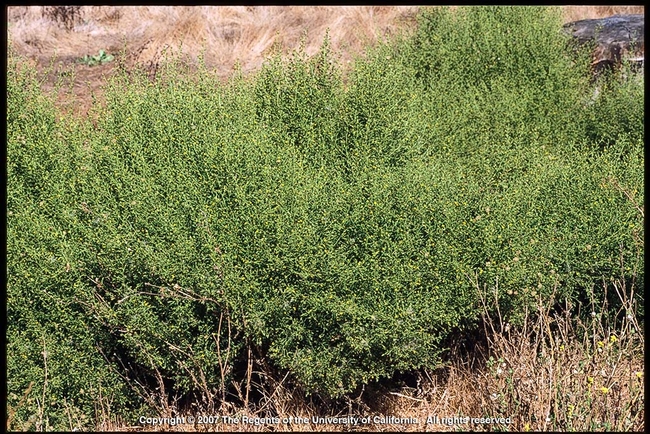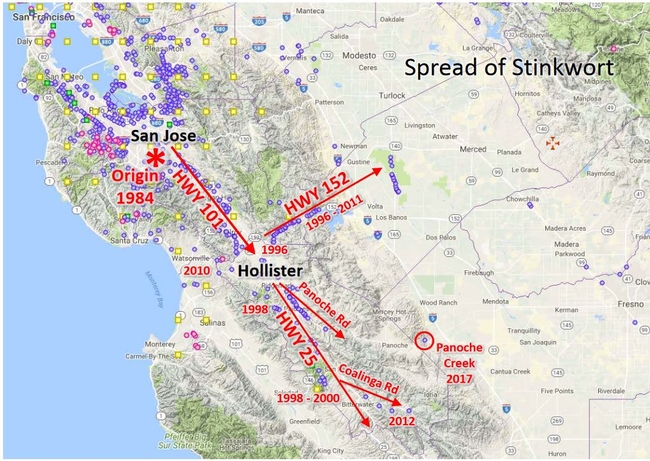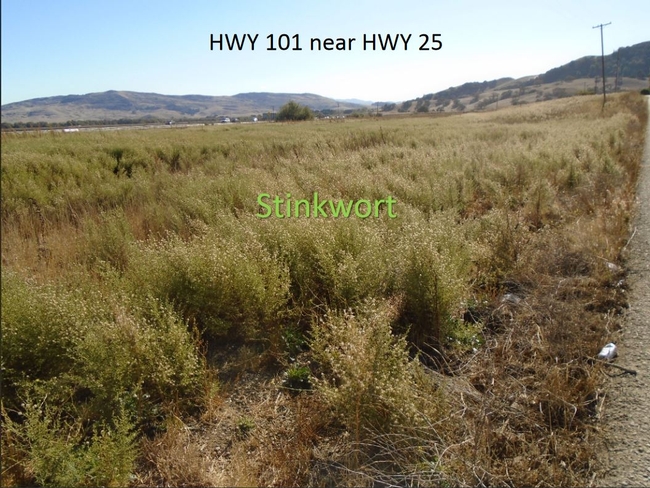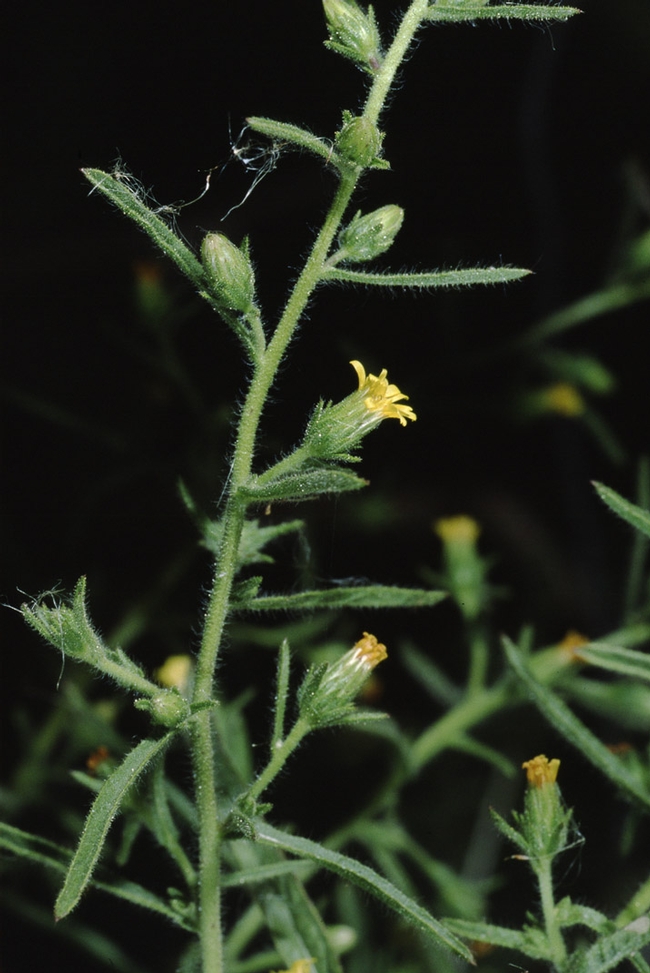Stinkwort (Dittrichia graveolens) is a very sticky annual weed in the sunflower family with a powerful smell similar to tarweeds (Brownsey et al. 2013). Its first observation in California was in Santa Clara County in 1984. Nearly 30 years later, it had expanded to more than 60% of the counties in the state. It has a unique growth form that looks like a Christmas tree, though it only grows up to 2.5 feet (O'Dell pers. comm., Brownsey et al. 2013). From a distance it can look like tumbleweed, also known as Russian thistle (Salsola sp.).

Ryan O'Dell is a Natural Resource Specialist with the Bureau of Land Management's (BLM) Central Coast Field Office and Amelia Ryan is a Vegetation Ecologist with Pinnacles National Park. Both are members of the San Benito County Weed Management Area. O'Dell has worked for BLM for the past 13 years and has been tracking the spread of stinkwort in San Benito County for the past eight years. He uploads his stinkwort observations into the Calflora database, which is available for free online. The database is essentially a map where you can see the date and location of the plant observations: https://www.calflora.org/cgi-bin/species_query.cgi?where-calrecnum=8482. According to Amelia Ryan, stinkwort often grows in disturbed soils, along roads, and around stock ponds in San Benito County. It is also locally abundant along gravely creek beds, like lower San Benito River and Tres Pinos Creek (Ryan, pers. comm., O'Dell, pers. comm.).
A plant on the move

In this map from Calflora, Ryan O'Dell added dates and arrows so we can more easily see how the plant spread. You can see the first sighting in California near San Jose in 1984 and how it spread from there. It spread south to Hollister by the mid-1990s and down Highway 25 to southern portions of San Benito County, including to Pinnacles National Park, by the late-1990s – 2000. Stinkwort was first recorded on Coalinga Road in 2012 and was recently observed in Panoche Creek in 2017. In addition to spreading south, it has spread east from Hollister on Highways 156 and 152 toward Pacheco Pass.
Impact to Rangeland
Stinkwort is similar to our native California tarweeds in that it does well in warm and dry Mediterranean climates (O'Dell, pers. comm.). Also like our native tarweeds, the species grows and flowers late into Summer. Most of San Benito County is within the warm and dry Mediterranean climate, so there is a lot of potential for this plant to spread throughout most of the county. The hottest and driest portions of the county like Panoche Valley and Vallecitos are likely not conducive to its spread, except for along the creeks where there is higher soil moisture.
It appears to be spreading along roads into the more rural parts of the county and can spread into rangeland from there, noted O'Dell. It has the potential to become widespread in similar habitats and at similar densities to yellow starthistle. Due to its very sticky and strongly aromatic foliage, stinkwort is not palatable and cattle avoid it, so it could substantially reduce the productivity of our rangelands if it gets dense.

Ways it can spread
O'Dell explained that stinkwort spreads exclusively by seeds, which can stay alive in the soil up to 10 years. The seeds can be attached to vehicles or animals, but most seeds of the species are believed to spread in movement of other materials like soil, gravel, or even hay or straw bales. Amelia Ryan has also noticed that some quarries have been heavily invaded by stinkwort. Stinkwort is thought to have arrived at Pinnacles National Park through aggregate material brought in to repair a bridge that washed out during a flood in 1998 (Ryan, pers. comm.). For the past 20 or so years, Pinnacles has been working to eradicate stinkwort from that one load of gravel that was brought into the park. Even today, there are still a few plants every year at Pinnacles. At the intersection of Highways 152 and 156, the HWY 156 flyover was completed in 2008 (O'Dell, pers. comm.). In that area, there's an eight-acre field that now has solid stinkwort. The disturbed field was invaded from stinkwort that was growing along the highway.
Stinkwort is also spreading along public roads because when the roads are graded, the seed is dragged and spread along the road edge with the graded soil (O'Dell, pers. comm.). Stinkwort loves disturbed soil, so disking can spread it, too. O'Dell observed a site where there is stinkwort along Hwy 25. From there, it invaded an adjacent vineyard. And through the disking practices of the vineyard, it is moving deeper into the vineyard.
What you can do to prevent spread
Early detection and rapid response are extremely effective at preventing spread of weeds. That means, learn to identify stinkwort and if you see a few individuals starting to invade your area, remove them right away. Based on Ryan O'Dell's mapping, stinkwort is widespread in the northern portion of the county, especially between Hollister and Paicines and between Hollister and Highway 152 to Pacheco Pass, so it's difficult to control it in those areas. However, it is very limited along Highway 25 south of Paicines, along Panoche Road, and along Coalinga Road. So, those are good places to keep an eye out and remove any plants you see. You might see O'Dell pulled over on Coalinga Road with his hoe removing stinkwort, in hopes of preventing its spread south. You can also alert Caltrans if you see any along Highway 25. And you are welcome to contact O'Dell if you see any stinkwort, and ask him to add your observation to the Calflora website. That way people can look to see if it is spreading into their area.
O'Dell asked me to consider the following, “Imagine a world where back in the late-1800s people were able to eradicate yellow starthsitle before it spread. Early detection and rapid response back then would have saved an incredible amount of time and money for land managers today. We have that opportunity today with stinkwort.”
In addition to early detection and rapid response, O'Dell says be cautious of where you purchase your soil, gravel, rock, hay or straw – it is buyer beware. He suggests that the best thing you can do is to inspect the location that the material is coming from to make sure there's no stinkwort on the pile or field you are going to purchase from. If you are not able to go to the location in person, contact the owner and ask if they have stinkwort in their yard or field. If there is stinkwort there, think twice about purchasing the material and potentially bring stinkwort to your land.
Chemical control
For more information about the lifecycle of the plant and how to control it using herbicides, see Stinkwort is rapidly expanding its range in California (http://calag.ucanr.edu/archive/?type=pdf&article=ca.v067n02p110).
Ryan O'Dell can be reached at rodell@blm.gov.
Amelia Ryan can be reached at Amelia_Ryan@nps.gov.
REFERENCES
Brownsey, R., G. Kyser, and J. DiTomaso. 2013. Stinkwort is rapidly expanding its range in California. California Agriculture, 67(2), pp.110-115. Last accessed July 30, 2020: http://calag.ucanr.edu/archive/?type=pdf&article=ca.v067n02p110.
O'Dell, R. 2020. Ryan O'Dell is Natural resource Specialist for the Bureau of Land Management's Central Coast Office. Personal communication on July 23, 2020.
Ryan, A. 2020. Amelia Ryan is Vegetation Ecologist for Pinnacles National Park. Personal communication on July 22, 2020.
Author - San Benito County Director and Area Livestock and Natural Resources Advisor
